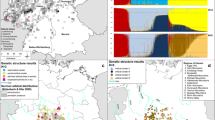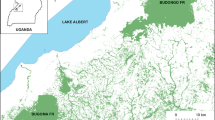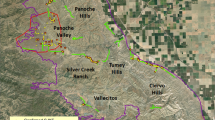Abstract
Little is known about the relatedness structure of carnivores living in urban areas, where green spaces may vary in size and resource availability. We examined the minimum population size, relatedness structure, and genetic diversity of a recently established population of eastern coyotes (Canis latrans) inhabiting New York City (NYC). The population has been established for approximately 25 years, and sample collection for genetic analysis has been ongoing since 2010. We genotyped 234 scat, eight tissue, and three blood samples at nine microsatellite loci. We identified 45 individual coyotes with a male-biased sex ratio of 2.2:1. We also found moderate to high levels of genetic diversity, with average observed heterozygosity of 0.779 and mean number of alleles per locus of 7.8. Most of the green spaces surveyed supported a single group of closely related coyotes in each. Relatedness comparisons between parks also indicated that coyotes compared across different parks were also closely related. We identified two unrelated mated pairs and found no support for polygamy. The high incidence of relatedness suggests that the coyote population is descended from a small number of founding individuals. Additionally, we genetically recaptured several coyotes, including one individual sampled in the Bronx and in Queens, with a median of 103 days between resampling. This result indicates that the coyotes are persisting in some of the isolated greenspaces of New York City and able to move successfully between them.






Similar content being viewed by others
References
Andelt W (1985) Behavioral ecology of coyotes in south Texas. Wildl Monogr 94:3–45
Atkinson KT, Shackleton DM (1991) Coyote, Canis latrans, ecology in a rural-urban environment. Can Field-Nat 105:49–54
Atwood TC (2006) The influence of habitat patch attributes on coyote group size and interaction in a fragmented landscape. Can J Zool 84:80–87
Atwood TC, Weeks H, Gehring T (2004) Spatial ecology of coyotes along a suburban-to-rural gradient. J Wildl Manag 68:1000–1009
Bateman PW, Fleming PA (2012) Big city life: carnivores in urban environments. J Zool 287:1–23
Bekoff M, Gese EM (2003) Coyote (Canis latrans). In: Feidhamer GA, Thompson BC, Chapman JA (eds) Wild mammals of North America: biology, management, and conservation, 2nd edn. Johns Hopkins University Press, Baltimore, pp 467–481
Bekoff M, Wells MC (1986) Social ecology and behavior of coyotes. Adv Stud Behav 16:251–338
Bekoff M, Daniels TJ, Gittleman JL (1984) Life history patterns and the comparative social ecology of carnivores. Annu Rev Ecol Syst 15:191–232
Blair RB (1996) Land use and avian species diversity along an urban gradient. Ecol Appl 6:506–519
Bowen WD, Cowan IM (1980) Scent marking in coyotes. Can J Zool 58:473–480
Bozarth CA, Gardner B, Rockwood LL, Maldonado J (2015) Using fecal DNA and spatial capture – recapture to characterize a recent coyote colonization. Northeast Nat 22:144–162
Bradley CA, Altizer S (2007) Urbanization and the ecology of wildlife diseases. Trends Ecol Evol 22:95–102
Chaves SL, Dias I, Pomilla C (2010) Extraction of genomic DNA from carnivore fecal samples using QIAamp DNA stool mini kit. http://www.amnh.org/content/download/69690/1196529/version/1/file/2010_stool_extraction_protocol.pdf. Accessed 5 May 2015
Crawford KM, Whitney KD (2010) Population genetic diversity influences colonization success. Mol Ecol 19:1253–1263
Csilléry K, Johnson T, Beraldi D, Clutton-Brock T, Coltman D, Hansson B, Spong G, Pemberton JM (2006) Performance of marker-based relatedness estimators in natural populations of outbred vertebrates. Genetics 173:2091–2101
Dakin E, Avise J (2004) Microsatellite null alleles in parentage analysis. Heredity 93:504–509
Damm DL, Armstrong JB, Arjo WM, Piaggio AJ (2015) Assessment of population structure of coyotes in east-Central Alabama using microsatellite DNA. Southeast Nat 14:106–122
DeBarba M, Adams JR, Goldberg CS, Stansbury CR, Arias D, Cisneros R, Waits LP (2014) Molecular species identification for multiple carnivores. Conserv Genet Resour 6:821–824
DeCandia AL, Henger CS, Krause A, Gormezano LJ, Weckel M, Nagy C, Munshi-south J, VonHoldt B (2019) Genetics of urban colonization: neutral and adaptive variation in coyotes (Canis latrans) inhabiting the New York metropolitan area. J Urban Ecol 5:1–12
ESRI (2016) ArcGIS desktop: release 10.6.1. Environmental Systems Research Institute, Redlands
Francisco LV, Langston AA, Mellersh CS, Neal CL, Ostrander EA (1996) A class of highly polymorphic tetranucleotide repeats for canine genetic mapping. Mamm Genome 7:359–362
Gehrt SD (2006) Urban coyote ecology and management: The Cook County, Illinois Coyote Project. Ohio State University Extension Bulletin 929:1–32
Gehrt SD, Riley SPD (2010) Coyotes (Canis latrans). In: Gehrt SD, Riley SPD, Cypher BL (eds) Urban carnivores: ecology, conflict, and conservation. Johns Hopkins University Press, Baltimore, pp 78–95
Gehrt SD, Anchor C, White LA (2009) Home range and landscape use of coyotes in a metropolitan landscape: conflict or coexistence? J Mammal 90:1045–1057
Gehrt SD, Brown JL, Anchor C (2011) Is the urban coyote a misanthropic synanthrope? The case from Chicago. Cities Environ 4:1–23
Gliwicz J, Goszczynski J, Luniak M (1994) Characteristic features of animal populations under synurbanization - the case of the blackbird and of the striped field mouse. Mem Zoologi 49:237–244
Godoy E, Norén K, Angerbjӧrn A (2018) Mating patterns in an inbred Arctic carnivore. Polar Biol 41:945–951
Gompper M (2002) Top carnivores in the suburbs? Ecological and conservation issues raised by colonization of North-Eastern North America by coyotes. BioScience 52:185–190
Greenwood PJ (1980) Mating systems, philopatry and dispersal in birds and mammals. Anim Behav 28:1140–1162
Grimm NB, Faeth SH, Golubiewski NE, Redman CL, Wu J, Bai X, Briggs JM (2008) Global change and the ecology of cities. Science 319:756–760
Grinder MI, Krausman PR (2001) Home range, habitat use, and nocturnal activity of coyotes in an urban environment. J Wildl Manag 65:887–898
Guyon R, Lorentzen TD, Hitte C, Kim L, Cadieu E, Parker HG, Quignon P, Lowe JK, Renier C, Gelfenbeyn B, Vignaux F, DeFrance H, Gloux S, Mahairas GG, André C, Galibert F, Ostrander EA (2003) A 1-Mb resolution radiation hybrid map of the canine genome. Proc Natl Acad Sci U S A 100:5296–5301
Harrison DJ (1992) Dispersal characteristics of juvenile coyotes in Maine. J Wildl Manag 56:128–138
Hennessy CA, Dubach J, Gehrt SD (2012) Long-term pair bonding and genetic evidence for monogamy among urban coyotes (Canis latrans). J Mammal 93:732–742
Heppenheimer E, Cosio DS, Brzeski KE, Caudill D, Van Why K, Chamberlain MJ, Hinton JW, Vonholdt B (2018) Demographic history influences spatial patterns of genetic diversity in recently expanded coyote (Canis latrans) populations. Heredity 120:183–195
Hody JW, Kays R (2018) Mapping the expansion of coyotes (Canis latrans) across North and Central America. ZooKeys 97:81–97
Holm S (1979) A simple sequentially rejective multiple test procedure. Scand J Stat 6:65–70
Holmes NG, Dickens HF, Parker HL, Binns MM, Mellersh CS, Sampson J (1995) Eighteen canine microsatellites. Anim Genet 26:132–133
Homer CG, Dewitz GA, Yang L, Jin S, Danielson P, Xian G, Coulson J, Herold ND, Wickham JD, Megown K (2015) Completion of the 2011 National Land Cover Database for the conterminous United States-representing a decade of land cover change information. Photogramm Eng Remote Sens 81:345–354
Hulme-Beaman A, Dobney K, Cucchi T, Searle JB (2016) An ecological and evolutionary framework for commensalism in anthropogenic environments. Trends Ecol Evol 31:633–645
Johnson RF (2001) Synanthropic birds of North America. In: Marzluff JM, Bowman R, Donnelly R (eds) Avian ecology and conservation in an urbanizing world. Springer, Boston
Johnson MTJ, Munshi-South J (2017) Evolution of life in urban environments. Science 358:1–11
Jones OR, Wang J (2010) COLONY: a program for parentage and sibship inference from multilocus genotype data. Mol Ecol Resour 10:551–555
Kalinowski ST, Wagner AP, Taper ML (2006) ML-RELATE: a computer program for maximum likelihood estimation of relatedness and relationship. Mol Ecol Notes 6:576–579
Kamler JF, Gipson PS (2000) Space and habitat use by resident and transient coyotes. Can J Zool 78:2106–2111
Kays RW, Gompper ME, Ray JC (2008) Landscape ecology of eastern coyotes based on large-scale estimates of abundance. Ecol Appl 18:1014–1027
Kearse MM, Wilson A, Stones-Havas S, Cheung M, Sturrock S, Buxton S et al (2012) Geneious basic: an integrated and extendable desktop software platform for the organization and analysis of sequence data. Bioinformatics 28:1647–1649
Kierepka EM, Kilgo JC, Rhodes OE (2017) Effect of compensatory immigration on the genetic structure of coyotes. J Wildl Manag 81:1394–1407
Kohn MH, York EC, Kamradt DA, Haught G, Sauvajot RM, Wayne RK (1999) Estimating population size by genotyping faeces. Proc R Soc B 266:657–663
Kraemer P, Gerlach G (2017) Demerelate: calculating interindividual relatedness for kinship analysis based on codominant diploid genetic markers using R. Mol Ecol Resour 17:1371–1377
Lonsinger RC, Waits LP (2015) ConGenR: a rapid determination of consensus genotypes and estimates of genotyping errors from replicated genetic samples. Conserv Genet Resour 7:841–843
Lukasik VM, Alexander SM (2011) Human-coyote interactions in Calgary, Alberta. Hum Dimens Wildl 16:114–127
Martin D (1999) Wild (and unleashed) coyote is captured in Central Park. New York Times, 148:51480, p B1
McDonnell MJ, Hahs AK (2015) Adaptation and adaptedness of organisms to urban environments. Annu Rev Ecol Evol Syst 46:261–280
McKinney ML (2006) Urbanization as a major cause of biotic homogenization. Biol Conserv 127:247–260
McNutt JW (1996) Sex-biased dispersal in African wild dogs, Lycaon pictus. Anim Behav 52:1067–1077
Milligan BG (2003) Maximum-likelihood estimation of relatedness. Genetics 163:1153–1167
Mitchell N, Strohbach MW, Pratt R, Finn WC, Strauss EG (2015) Space use by resident and transient coyotes in an urban-rural landscape mosaic. Wildl Res 42:461–469
Moore GC, Millar JS (1984) A comparative study of colonizing and longer established eastern coyote populations. J Wildl Manag 48:691–699
Morton NE (2002) Linkage disequilibrium. In: Brenner S, Miller JH (eds) Encyclopedia of genetics, Vol 1. Academic Press, p 1105
Mumma MA, Soulliere CE, Mahoney SP, Waits LP (2014) Enhanced understanding of predator-prey relationships using molecular methods to identify predator species, individual and sex. Mol Ecol Resour 14:100–108
Nagy CM, Koestner C, Clemente S, Weckel M (2016) Occupancy and breeding status of coyotes in New York City parks, 2011 to 2014. Urban Nat 9:1–19
Nagy C, Weckel M, Monzón J, Duncan N, Rosenthal MR (2017) Initial colonization of long island, New York by the eastern coyote, Canis latrans (Carnivora, Canidae), including first record of breeding. Check List 13:901–907
Nellis CH, Keith LB (1976) Population dynamics of coyotes in Central Alberta, 1964-68. J Wildl Manag 40:389–399
Nowak DJ, Greenfield EJ (2012) Tree and impervious cover in the United States. Landsc Urban Plan 107:21–30
NYC Parks (2019) About the New York City Department of Parks. Available at www.nycgovparks.org/about (Accessed March 2, 2019)
Ostrander EA, Sprague GF Jr, Rine J (1993) Identification and characterization of dinucleotide repeat (CA)n markers for genetic mapping in dog. Genomics 16:207–213
Peakall R, Smouse PE (2006) GenAlEx 6: genetic analysis in excel. Population genetic software for teaching and research. Mol Ecol Notes 6:288–295
Peakall R, Smouse PE (2012) GenAlEx 6.5: genetic analysis in excel. Population genetic software for teaching and research--an update. Bioinformatics 28:2537–2539
Piry S, Luikart G, Cornuet JM (1999) BOTTLENECK: a computer program for detecting recent reductions in the effective population size using allele frequency data. J Hered 90:502–503
Prugh LR, Ritland CE, Arthur SM, Krebs CJ (2005) Monitoring coyote population dynamics by genotyping faeces. Mol Ecol 14:1585–1596
Queller DC, Goodnight KF (1989) Estimating relatedness using genetic markers. Evolution 43:258–275
Quinn T (1997) Coyote (Canis latrans) habitat selection in urban areas of western Washington via analysis of routine mouvements. Northwest Sci 71:289–297
R Core Team (2018) R: A language and environment for statistical computing. R Foundation for Statistical Computing, Vienna, Austria. http://www.R-project.org
Randall DA, Pollinger JP, Wayne RK, Tallents LA, Johnson PJ (2007) Inbreeding is reduced by female-biased dispersal and mating behavior in Ethiopian wolves. Behav Ecol 18:579–589
Riley SPD, Sauvajot RM, Fuller TK, York EC, Kamradt DA, Bromley C, Wayne R (2003) Effects of urbanization and habitat fragmentation on bobcats and coyotes in southern California. Conserv Biol 17:566–576
Riley SPD, Pollinger JP, Sauvajot RM, York EC, Bromley C, Fuller TK, Wayne RK (2006) A southern California freeway is a physical and social barrier to gene flow in carnivores. Mol Ecol 15:1733–1741
Rousset F (2008) GENEPOP’007: a complete re-implementation of the GENEPOP software for Windows and Linux. Mol Ecol Resour 8:103–106
Ryden H (1974) The “lone” coyote likes family life. Natl Geogr 146:279–294
Sacks BN, Brown SK, Ernest HB (2004) Population structure of California coyotes corresponds to habitat-specific breaks and illuminates species history. Mol Ecol 13:1265–1275
Sacks BN, Ernest HB, Boydston EE (2006) San Francisco’s Golden Gate: a bridge between historically distinct coyote (Canis latrans) populations. West N Am Naturalist 66:263–264
Seddon JM (2005) Canid-specific primers for molecular sexing using tissue or non-invasive samples. Conserv Genet 6:147–149
Serieys LEK, Lea A, Pollinger JP, Riley SPD, Wayne RK (2015) Disease and freeways drive genetic change in urban bobcat populations. Evol Appl 8:75–92
Seto KC, Güneralp B, Hutyra LR (2012) Global forecasts of urban expansion to 2030 and direct impacts on biodiversity and carbon pools. Proc Natl Acad Sci U S A 109:16083–16088
Slatkin M (1977) Gene flow and genetic drift in a species subject to frequent local extinctions. Theor Popul Biol 12:253–262
Slatkin M (2008) Linkage disequilibrium - understanding the evolutionary past and mapping the medical future. Nat Rev Genet 9:477–485
Sparkman AM, Adama JR, Steury TD, Waits LP, Murray DL (2012) Pack social dynamics and inbreeding avoidance in the cooperatively breeding red wolf. Behav Ecol 23:1186–1194
Stenglein JL, Waits LP, Ausband DE, Zager P, Mack CM (2010) Efficient, noninvasive genetic sampling for monitoring reintroduced wolves. J Wildl Manag 74:1050–1058
Taberlet P, Luikart G, Waits LP (1999) Noninvasive genetic sampling: look before you leap. Trends Ecol Evol 14:323–327
Tigas LA, Van Vuren DH, Sauvajot RM (2002) Behavioral responses of bobcats and coyotes to habitat fragmentation and corridors in an urban environment. Biol Conserv 108:299–306
Toomey AH, Weckel M, Nagy C, Gormezano LJ, Silver S (2012) The last frontier: eastern coyotes in New York City. The Wildl Prof 6:54–57
Trombulak SD, Frissell CA (2000) Review of ecological effects of roads on terrestrial and aquatic communities. Conserv Biol 14:18–30
United Nations (2018) World population prospects: the 2018 revision. New York, NY https://population.un.org/wup/Publications/Files/WUP2018-Report.pdf. Accessed 7 Feb 2019
United States Census Bureau (2018) New York city census. https://www.census.gov/quickfacts/fact/table/newyorkcitynewyork/PST045218. Accessed 29 Jan 2019
Valière N (2002) GIMLET: a computer program for analysing genetic individual identification data. Mol Ecol Notes 2:377–379
Van DeCasteele T, Galbusera P, Matthysen E (2001) A comparison of microsatellite-based pairwise relatedness. Mol Ecol 10:1539–1549
Van Oosterhout C, Hutchinson WF, Wills DPM, Shipley P (2004) MICRO-CHECKER: software for identifying and correcting genotyping errors in microsatellite data. Mol Ecol Notes 4:535–538
Waits LP, Paetkau D (2005) Noninvasive genetic sampling tools for wildlife biologists: a review of applications and recommendations for accurate data collection. J Wildl Manag 69:1419–1433
Waits LP, Luikart G, Taberlet P (2001) Estimating the probability of identity among genotypes in natural populations: cautions and guidelines. Mol Ecol 10:249–256
Way JG, Auger PJ, Ortega IM, Strauss EG (2001) Eastern coyote denning behavior in an anthropogenic environment. Northeast Wildl 56:18–30
Way JG, Ortega IM, Auger PJ (2002) Eastern coyote home range, territoriality, and sociality on urbanized Cape Cod. Northeast Wildl 57:1–18
Way JG, Rutledge L, Wheeldon T, White BN (2010) Genetic characterization of eastern “coyotes” in eastern Massachusetts. Northeast Nat 17:189–204
Weckel M, Bogan DA, Burke RL, Nagy C, Green T (2015) Coyotes go “ bridge and tunnel ”: a narrow opportunity to study the socio-ecological impacts of coyote range expansion on Long Island, NY pre- and post-arrival. Cities and the Environment 8:1–28
Wickham H (2016) ggplot2: elegant graphics for data analysis. Springer-Verlag, New York
Wultsch C, Waits LP, Hallerman EM, Kelly MJ (2015) Optimizing collection methods for noninvasive genetic sampling of neotropical felids. Wildl Soc Bull 39:403–412
Acknowledgements
We thank the Gotham Coyote Project (GCP; New York City, New York) for providing the samples for this study. We thank the NYC Department of Parks and Recreation Wildlife Unit for assistance with sample collection. Funding for this study was provided by the Clare Boothe Luce Graduate Fellowship Program, the Mianus River Gorge Research Assistantship Program, the National Science Foundation Research Experience for Undergraduates (REU) Program (Award #1063076), and the Louis Calder Graduate Student Research Grant.
Author information
Authors and Affiliations
Corresponding author
Electronic supplementary material
ESM 1
(PDF 173 kb)
Rights and permissions
About this article
Cite this article
Henger, C.S., Herrera, G.A., Nagy, C.M. et al. Genetic diversity and relatedness of a recently established population of eastern coyotes (Canis latrans) in New York City. Urban Ecosyst 23, 319–330 (2020). https://doi.org/10.1007/s11252-019-00918-x
Published:
Issue Date:
DOI: https://doi.org/10.1007/s11252-019-00918-x




